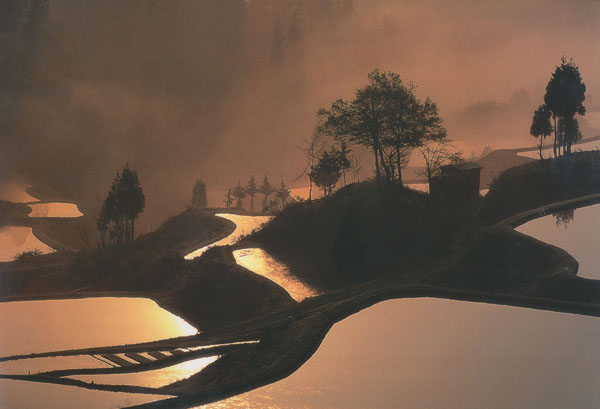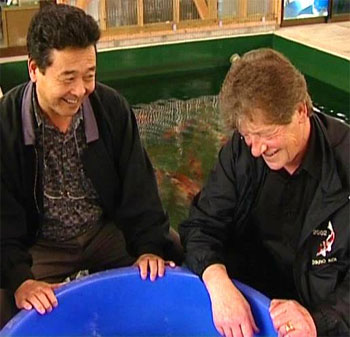Buying Koi in Autumn.
This period, as mentioned earlier, is THE time for serious Koi buyers or collectors. The sleepy villages burst into activity after all indoor systems have been filled and running operation has been witnessed. Harvest nets are brought from storage and checked; larger trucks are prepared with oxygenated containers secured on their long, flat beds; new oxygen cylinders are loaded and secured and chest waders and other items are all in preparations for the thousands of harvests that will soon take place. There is an air of excitement and apprehension that can be felt by the visitors, right up to the moment a ‘non-audible signal’ is sounded when the trucks mysteriously start rolling away to their respective destinations.
It is also the most beautiful time of the year to visit Yamakoshi especially as the mountainsides begin to change colour when the leaves on the trees turn from green to yellow and then to every shade of red imaginable.
I cannot exactly recall when I first innocently asked some breeders if I could travel with them to witness and photograph an actual harvest taking place although it was around the early 1980’s. The initial reply was ‘Oh it is very muddy and wet, please stay at my house with our Japanese customers and take refreshments, then we will collect the Koi and return them for you to see properly in the concrete ponds’! Some found it amusing that I wanted to spend a few hours watching and recording them carry out their work for the first time but they had no idea as to just how badly I wished to witness these events for the very first time. It may have been a couple of years after when one breeder suggested that, if I wished, I could actually help lift the Koi from the mud with my own hands. For me, at the time, it was one of my wildest dreams to be able to do just that and I will never forget that very first harvest I actually took part in.
(Just for the record, it was in a small mud pond near Ojiya owned by the late Kozaburo Miya in 1983 – he was brother to the Miyaishi outlet in Uragara village and could ‘smell’ a quality Koi blindfolded!)
In later years the breeders realised just how much their foreign visitors loved to take part in these events and, by the mid 1990’s this all became ‘de rigueur’. Today, most breeders encourage overseas visitors to attend and take part in their harvests, they also lay on drinks and snacks for them whilst they are observing the events. As far as I am aware I was the first foreign visitor to actually experience this physically by getting wet and muddy and reveling in it all.
Some breeders commence harvesting around the 8th. October but this can be postponed if the weather is exceptionally mild and further growing can be achieved. The larger breeders start around the 18th. October, fully aware of the No-gyo-sai (Agricultural Society) breeders show staged at the last weekend of the month where many breeders proudly display the best fruits of their harvests in serious competition with each other. It is an important showcase for enthusiasts and breeders from other parts of Japan and all local hotels are difficult to reserve at this time.
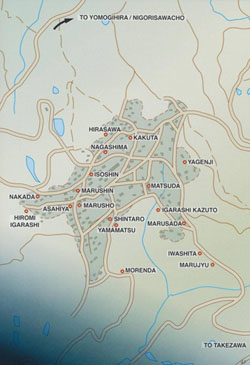 As to the selection of Koi on offer in the breeder’s indoor facilities, these can vary greatly even on a daily basis as more harvests are returned. It is rare indeed that advance expectations from visitors can not be realised, in truth the choice is truly amazing in respect of quantity, size, variety and quality of the Koi harvested. In the majority of cases it is not ‘which one’ that one wishes to buy that presents a problem, it is rather ‘which twenty’ or more that becomes the real problem. Then, at the back of the mind always comes the question – ‘What will be harvested tomorrow or the day after or the day after that – should I wait? – will there be even better Koi available then’?
As to the selection of Koi on offer in the breeder’s indoor facilities, these can vary greatly even on a daily basis as more harvests are returned. It is rare indeed that advance expectations from visitors can not be realised, in truth the choice is truly amazing in respect of quantity, size, variety and quality of the Koi harvested. In the majority of cases it is not ‘which one’ that one wishes to buy that presents a problem, it is rather ‘which twenty’ or more that becomes the real problem. Then, at the back of the mind always comes the question – ‘What will be harvested tomorrow or the day after or the day after that – should I wait? – will there be even better Koi available then’?
To give some kind of idea of the density of Koi breeders available to see in autumn, this is a map of Mushigame village where all the breeders shown can be accessed on foot.
Since around 1984 I have always stayed for the full two month period in order to find my stocks but from around 1995 more and more guests joined our party each year. By 2000 we had to hire three people carriers and staff to escort collectors from many parts of the world in order to find their special Koi. These parties were made up of seven to ten day visits and when some left for home, others came to take their places. However, there were always a few ‘rest days’ where we (Dennis and myself) had time to get to the smaller breeders in Tanesuhara, Tochio, Koide and Wakatochi to try and find more stocks for re-sale or for other enthusiasts who could not make the visit themselves. Needless to say, the evening paperwork involved after a busy day in the mountainsides could take up to five hours to complete properly.
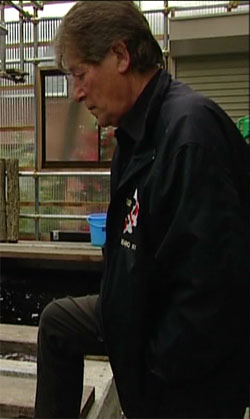 I also used this eight week period to build up a shopping list of notable and expensive specimens seen at many of the breeders during countless return visits and would spend some serious time just viewing them from all angles in the ponds. In some instances a Koi would be netted for inspection and measured before being released when I would make a note of the size as I saw it measured by the breeder. As the visit came towards its end I would then return to view again with a possibility of purchase. True, there were odd occasions when a Koi I wished to buy had already been sold but that is a chance one has to take. All of this takes time and concentration in studying the Koi on many visits and, if one was required by a collector for show purposes, I also had to have a good idea as to the competition element in Koi from other collectors that could be entered in direct competition, within the same size group and classification, at the same show. All of this had to be stored in my head from memory when attempting to make comparisons between Koi that may just have well been a million miles from each other. It is always a matter of looking and studying with self-imposed patience for hours on end over many return visits to find just that ‘one special Koi’. More on this later.
I also used this eight week period to build up a shopping list of notable and expensive specimens seen at many of the breeders during countless return visits and would spend some serious time just viewing them from all angles in the ponds. In some instances a Koi would be netted for inspection and measured before being released when I would make a note of the size as I saw it measured by the breeder. As the visit came towards its end I would then return to view again with a possibility of purchase. True, there were odd occasions when a Koi I wished to buy had already been sold but that is a chance one has to take. All of this takes time and concentration in studying the Koi on many visits and, if one was required by a collector for show purposes, I also had to have a good idea as to the competition element in Koi from other collectors that could be entered in direct competition, within the same size group and classification, at the same show. All of this had to be stored in my head from memory when attempting to make comparisons between Koi that may just have well been a million miles from each other. It is always a matter of looking and studying with self-imposed patience for hours on end over many return visits to find just that ‘one special Koi’. More on this later.
Never stop looking, never stop remembering and never stop learning.
Looking for these beauties is always with one’s own eyes in order to evaluate them properly and that is the only ‘tool’ I have ever used. Whatever you do in your endeavours, do not listen to the ‘silly terms’ and ‘vital requirements’ often quoted at meetings by so-called ‘Koi Judges’ of the day. Nonsense such as ‘pattern is not important’ and ‘Sanke must not have sumi on the head or face’ are ‘tripe’ that is spouted by many to impress their opened-mouthed and eager listeners over a few beers. Providing skin, frame and volume of several Koi swimming together in a show pond is just about equal then the pattern aspect is of paramount importance and is the single item that makes a Koi truly unique. I have recently asked myself how I view a pond of Koi for sale with the possibility of making a purchase and, without exception, my eyes look for pattern first and foremost, then follows the quality of pigmentation, the skin shine and finally to frame and body shape which obviously varies greatly with age as it does with humans. In short, if the pattern is not there to start with, I look no further. The Japanese breeders converse with these ‘expert and important’ judges as politely as possible, always nodding their heads in agreement and smiling at the appropriate times. But just watch one of these breeders selecting his tategoi and, whilst skin and pigmentation are seriously considered, the top ones selected ALWAYS have truly wonderful patterns as well in ANY size.
It is common knowledge that cosmetic surgery is used by meny Koi breeders to enhance pattern on Koi with potential and many menkaburi patterns on an otherwise stunning pattern can be changed with care, expertise and the correct pigment removal chemicals correctly applied. If these are not applied correctly for the required duration then it will be detected later by the return of what is termed as ‘Niban Hi’ – although this is far from common, one thing is certain and that is it has been carried out on a Koi with some future value.
Whilst I have observed this on many occasions I have never seen surgery carried out on any tancho varieties although it probably may be done by some breeders. It is generally only Go-Sanke where there is far more importance placed.
It is said that, recently, the ZNA judges have been requested to make even more severe disqualifications if a Koi before them is suspected of being ‘cosmetically modified’.
I assure you, if a Koi HAS been cosmetically modified by an expert breeder, it will be almost impossible for any judge to detect this several years later!
Personally speaking, I am not in favour of this kind of surgery but detecting expert surgery some years down the line is very difficult indeed.
If I had ever considered listening to these words of wisdom spewed forth by these Koi experts I would yet have never found and purchased one single Supreme Champion for the coveted BKKS National show. Thankfully, by giving these ‘gospels’ a very wide berth and trusting my own eyes instead, I have eighteen of these awards to my name including the 2009 one at the time of writing much to the intense annoyance of some others when I remind them – and I try to do this as often as is required and at every turn of the conversation if required – they get terribly frustrated when they cannot give any intelligent replies because true, recorded facts are very hard to dispute!
However, there are true experts of Nishikigoi and these are not the ones who often quote meaningless, futile words and the associated ‘ZNA-invented terms’ to the wide-eyed whom they can easily impress. These are the guys I have looked up to, and still do, for more years than I care to recall. They put their neck on the line and back it up with hard cash, on almost a daily basis, by paying small fortunes for a single Koi which they know can be developed into something serious in years to come – they also know exactly how they will be able to do this providing everything required is not plagued by the ever-present chance of misfortune that does abound. Not only can these guys ‘sniff’ out quality 50 metres from a pond, some of these Koi may look, on first inspection, absolutely average to others. However, the breeder who produced it also is well-aware of its potential. Some of these idols of mine have grown up with Koi since birth, assessing the value of any Koi within a mere 10 seconds comes to them as second nature, in short, these are the true masters. In this sort of company I readily and openly realise my own, very significant limitations and shortfalls! I also know I will never reach that level.
 Q. ‘Tell me please , does this fine Sanke display the true and very rare and beautiful ‘Atarashi Sumi’ that our judges actually need to be able to instantly assess and write volumes of important words about in order to teach us eager underlings?’
Q. ‘Tell me please , does this fine Sanke display the true and very rare and beautiful ‘Atarashi Sumi’ that our judges actually need to be able to instantly assess and write volumes of important words about in order to teach us eager underlings?’
 A. ‘What on earth are you talking about Peter San – have you been drinking so early yet again? I’m just a very humble yet world-famous Koi breeder and this is one of my better Sankes please buy it from me, I could do with some extra pocket money for my overdue golf club fees’!
A. ‘What on earth are you talking about Peter San – have you been drinking so early yet again? I’m just a very humble yet world-famous Koi breeder and this is one of my better Sankes please buy it from me, I could do with some extra pocket money for my overdue golf club fees’!
I have given Koi lectures in many countries around the world over many years and I will always overhear words of absolute nonsense spouted over evening get-togethers by those who truly believe they know ‘a thing or two’ when it comes to assessing a Koi. I get embarrassed beyond belief and walk away, trying to imagine just how pompously and seriously they believe they ‘do know’ – if they were faced with the few guys on this planet that actually do!
Furthermore, on this subject, there is a huge world of difference between merely talking about the virtues and de-merits of any Koi seen at shows or by photographs versus finding, viewing, inspecting, with only one’s own eyes as a tool, and then paying £30,000.00 or so of one’s own cash to the breeder before taking all the uninsured risks and expenses in getting it back to the final destination.
After this one then has to face the real truth of the matter – namely selling it at a good profit and the ultimate ‘I told you so’ by watching it take the desired award at an important show. Alas, there are always instances where mistakes or bad luck comes along that have to be swallowed. Actually buying serious Koi and paying for them with one’s own money is a job for the big boys – and not the many that merely talk about it on the sidelines and attempt to surround it all with some kind of mystique that only they have the blessed fortune to possess.
I’m reasonably happy with my ‘eye’, although I admit it could be much better – it has served me well with the desired and recorded results over many years of being involved. I would dearly love to see one of the illustrious Koi judges of today standing at a pond of superb Koi with a large amount of his own money knowing he had to make a decision to find a champion with only one tool – namely his very own eyes. I have yet to be present at any such situation in all my life and if I ever could be present to witness this, I am sure the aroma of bodily discharges would be heavily-present in the air. A word of advice here, we all need to know more about evaluating special Koi – the people to speak with here are the people who produce them or actually own them. These are the guys who ‘know’ and not those who pass comments on them to further their own self-importance.
And now returning to the closing week of a usual eight week autumn visit to Yamakoshi. By then I will have a mental list of ‘special and very special Koi’ to consider at various outlets and I know that some may well have been sold whilst I have made lengthy deliberations on all the contenders. I also know I cannot possibly do this whilst guests are present as this is a lengthy process by necessity. The exact time to put my money where my mouth is has finally arrived again for yet another year and I am more than well-aware of this as we drive to the respective outlets. These breeders have now returned to some semblance of calm after buyers have departed and the important shows are in the past. At one outlet, I am seriously interested in two Koi but there are another three that deserve close inspection. (I am recalling here an event that actually took place in 2003.) Initially I carefully point out seven Koi and these are caught carefully and placed in a large bowl before me together with a couple of airstones. Although I may have ‘watched’ all these Koi on many earlier visits and possibly even seen some at close quarters, now is the time to really evaluate them. My attention first goes to the three ‘also-rans’ to discover that each is worthy of getting a price for as is one I had never even considered before and so the one that produces no interest is placed back into the pond. I now have three Kohaku, one Showa and two Sankes before me knowing full-well that one Kohaku and one Sanke will be far more costly than the other four. However, the other four could be readily purchased if my expected buying price can be achieved because all six are excellent Koi. Although this is rarely necessary but it is important, I check every single aspect of the Koi themselves as to body, shape, fins, mouth formation and position of the eyes. Next I look very closely at the skin shine and then move on the quality of the pigmentation – all this takes a mere minute or so. The next move is to ask the breeder to measure each Koi and I watch as closely as the breeder before writing down the respective sizes. I always ask ages of the Koi especially in recent years as some large sansai and some small yonsai can be confusing but I have long since stopped asking details of the original bloodlines which are now really unimportant other than for historical purposes. I then ask the prices of the Koi by pointing to each in the order of worst to best in my eyes and then take in the quoted prices in my head. More often than not my order of valuation is accurate although there have been many exceptions over the years. As to my advance expected buying price, I always err on prices which are lower than those that the breeder asks. Some minutes before I have a price in mind that I would buy at and have also included in this the reasonably accurate expenses involved for my costs in making the trip and total freight/clearance costs to get the Koi back home before adding a percentage of my business overheads. At the same time I already have some idea of my price required when I sell these to other collectors in order to produce a reasonable and vital profit.
Right now I am faced with the asking price from the breeder of ‘X’ for all six Koi when I wish to buy at ‘X minus 35%’ and so the dealing commences. I point to three assorted prices of Koi and ask for a total price if I buy all three, this takes a while for the answer to come from the breeder as he studies the Koi in question closely. The individually-quoted prices of the three will add to ‘Q’ but my reply comes back as ‘Q minus 20%’ – (I never ask for price reductions from most of these breeders, these reductions may be reluctantly given on one visit but will be added-on to kick you in the teeth on the next!) – and so the game continues. Eventually I get a price for five of the six Koi which, individually would total ‘R’ but now I need to get ‘R minus 25%’ for all five.
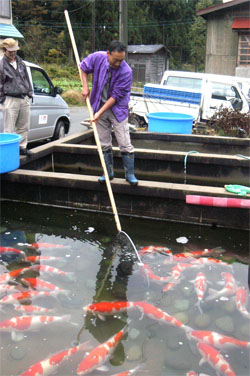 Finally as I am about to return one Koi (which I do wish to buy) back into the pond, I mention casually – ‘Oh, please give me your best price for all six Koi.’ In due course I get ‘X minus 30%’ – closer to what I am looking for in the first place but not quite. The breeder and I gaze closely at the six Koi before he stands up and places the seventh Koi previously rejected back into the bowl and says ‘Service!’ which means I get this one free if I take the ‘X minus 30%’ offer. A quick calculation takes place in my head when I realise my final price for all seven Koi is ‘X minus 32%’ – close enough for me. I simply say ‘OK’, we shake hands and then I pay the cash. The deal is now completed and we usually retire to the house for refreshments and a break.
Finally as I am about to return one Koi (which I do wish to buy) back into the pond, I mention casually – ‘Oh, please give me your best price for all six Koi.’ In due course I get ‘X minus 30%’ – closer to what I am looking for in the first place but not quite. The breeder and I gaze closely at the six Koi before he stands up and places the seventh Koi previously rejected back into the bowl and says ‘Service!’ which means I get this one free if I take the ‘X minus 30%’ offer. A quick calculation takes place in my head when I realise my final price for all seven Koi is ‘X minus 32%’ – close enough for me. I simply say ‘OK’, we shake hands and then I pay the cash. The deal is now completed and we usually retire to the house for refreshments and a break.
It’s funny and I do not really know how this works, but the more I am convinced that I have ‘overpaid’ on a deal, the more profitable it turns out for me after selling the Koi involved back home!
A small outlet not exactly well-known around the world but there are usually some serious Kohaku to be found here, especially at the right time.
Finally, I have been involved in this for some thirty years now and in terms of ‘total monetary value purchased’ as opposed to ‘numbers purchased’ I know of no-one else who has beaten the accumulated total I have spent on Nishikigoi to date although I stand to be corrected. I would not even begin to try and evaluate this final total – it would be positively frightening, believe me.
I also never once considered this as ‘real money’ – it could have just as well paid to me in Koi vouchers’ because that is all I spent it on!
Just to think, when I started out in ’72 a Koi priced at over £25.00 was positively outrageous and well beyond serious consideration!

